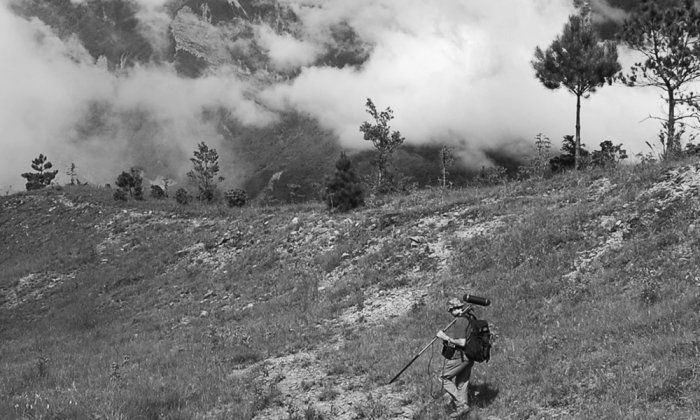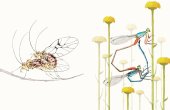Frogs Want to Be Heard. Yannick Dauby Is Listening.

Night has fallen over Guandu Nature Park in Taipei. Yannick Dauby is quietly striding through one section of its 140 acres of ponds, wetlands and brack waters, carrying bags brimful with equipment and a boompole. For Dauby, this is the best time of the day, the moment human noises slowly ebb away and the heat becomes somewhat bearable, the moment the snakes come out. The latter, as the French sound artist will later tell me with palpable enthusiasm, are “part of the pleasure” for him.
But Dauby isn’t looking for snakes, at least not tonight. He is driven by the memory of an encounter with an outwardly far less impressive creature: Rhacophorus moltrechti is so small that the uninitiated observer probably wouldn’t even notice it unless you were standing right next to it — it’s roughly the size of a child’s pinkie. With its garish-green skin and reddish pants, many might just as easily confuse it for its cousin, Hylaarborea, the European tree frog. Rhacophorus moltrechti isn’t even present in Guandu Nature Park. And yet, to Dauby, it has taken on an almost spiritual significance.

The story of his first encounter with Rhacophorus moltrechti’s hard-to-resist “soft timbre, round-shaped and woody character and its three descending tones” dates back to an August day in 2005 in the Southern mountains. Even when he’s speaking about it now, it sounds as though he’s describing some kind of personal epiphany, the kind of life-changing experience that some might associate with marriage or the birth of their child: “At noon, while the cicadas were singing loudly, I heard a surprising sound four or five times. I was surprised and recorded a very short sample before it stopped. I came back to France shortly afterwards and had to wait one year, before Professor Yang Yi-Ru introduced me to this fascinating endemic tree frog. It became a kind of personal mythological sound that perfectly represents my experience of Taiwan.” Since then, Dauby has spent countless hours recording the sounds of the frogs of Taiwan. Eventually, the results of his endeavors were published on a now sold-out CD containing 16 pristinely realized audio portraits. That said, the project is far from completed.
Back in Guandu, after wandering about seemingly aimlessly for a while, Dauby has found a nice spot and starts unpacking his gear in the moonlight. Although it has by now become significantly cooler, special condenser microphones, capable of resisting the humidity, are still required. So is the boompole. Frogs may be easy to record once you’ve found them, but being sensitive to movement rather than shapes and colors (“Just stay still, and they’ll restart singing,” according to Dauby), you still need to get as close to them as possible. Here, the boompole comes in handy: “There is nothing like the feeling of having a microphone located a few centimeters next to the mouth of a nice frog! It’s like putting my ear just above the strings of a musical instrument.”
In Germany, there have been numerous lawsuits initiated by sleepless frogophobes trying to force their neighbors to fill up their ponds with concrete and chase the animals away.
Needless to say, not everyone shares his excitement. The sound of even some of the more common species can reach ear-spitting levels and since frogs have the tendency to reach their peak at night, in Germany, for example, there have been numerous lawsuits initiated by sleepless frogophobes trying to force their neighbors to fill up their ponds with concrete and chase the animals away. Of course, biologically speaking, frogs have to be this insistent to stand a chance of reproducing. Since the calls of male frogs are easily drowned out by the myriads of competitors as well as the noises produced by other species, mating has turned into a survival of the loudest. Nonetheless, the disparity between their unassuming size and volumes of more than 75 decibels remains remarkable. And because of fascinating facts like this, Dauby still hasn’t lost his pure love for spending time near the frogs without any conceptual considerations. And as he slowly moves his boompole toward a frog, that’s precisely what he’s going to do tonight.
A second home
In terms of recording, tonight’s excursion is an exception. With large roads nearby creating a constant rumble, Guandu Nature Park, despite its undeniable beauty, is more of a meeting place and home base for a small but tightly-knit community of animal scientists, ornithologists, herpetologists or entomologists. And so, to capture the best frog sounds, Dauby has journeyed all over Taiwan: “I recorded Rhacophorus in the Alishan mountains, the beautiful Rhacophorus aurantiventris near Taitung in the South, the rare Babina okinavana in a tiny pond in central Nantou, the common toads (Duttaphrynus melanostictus) in Peng-Hu archipelago and even in the campus of the National Taiwan University of the Arts in Taipei!” he tells me. “Actually, I often go for walks with the other volunteers of Guandu Nature Park in the surrounding hills of Taipei, which are full of amphibians because of their high humidity. I also had the immense chance to spend some nights in Fushan Botanical Garden, which is a wonderful nature reserve.”

And yet, in terms of conducting his research, there really couldn’t be a better place for Dauby than Guandu. In a way, it has turned into a second home for him. Not only is he spending a lot of time in it as a field recordist but since he moved to Taiwan in 2004, he has also worked here as a volunteer. There is a lot of work to be done: Located in the North of the country at the junction of the Danshui and Jilong rivers, environmentalists fought for decades to convince authorities of turning it into a natural preserve and now they’ve been given their chance, they don’t intend to waste it. An important first step was taken in 1983, with the creation of the Guandu Waterbird Refuge, although economic aspects of tourism still played into the decision.
In 2001, however, a major breakthrough occurred when management of the park was handed over to a non-governmental organization, the Wild Bird Society of Taipei. With all proceeds flowing back into the park, it has since flourished and turned into a national symbol of pride. With 283 different species at present, birds are still unsurprisingly the most important animal here. But it is precisely the astounding all-around biodiversity that makes the enclosure so valuable. Wetlands are important because they are the habitat of a large number of animal and plant species’. According to Guandu Nature Park administrator Lin Yi-tzai, “The volume of life wetlands can support is 2.5 to 4 times that of a regular piece of land. If they are well preserved, the biodiversity that they host would also be preserved and the soundness of the world’s ecosystem can be maintained.”
It is a diversity visitors can not just see, but hear as well. Especially for Dauby, who grew up in a dry and arid Southern region of France, with only a single frog species singing on a regular basis, the wealth of sounds to be witnessed is almost intoxicating: Hylarana latouchii, with its low volume growlings and occasional click sounds; Microhyla fissipes, whose percussive song is excruciatingly loud thanks to a vocal bag the size of its entire body; Kurixalus eiffingeri, which produces a series of soft notes separated by a few seconds of silence. And then there is the Odorrana swinhoana, a “quite big frog living in rivers and streams where the water is active, and therefore full of the oxygen required for its reproduction” whose “short, intense, and very high-pitched” call cuts through its noisy surroundings and serves as an intriguing case of a species adapting to its environment.
Yang once came upon a dying frog near a spa. Without hesitating for even a second, she pressed its heart with her finger and breathed into its mouth.
Other than that, the encounter with civilization hasn’t always been equally positive: “I read at least one paper about frog communication changing over time due to human contact. Human-made noise affects the acoustic behaviors of some amphibians, and therefore decreases their chance for reproduction,” Dauby tells me. “For sure, frogs are very sensitive to human presence, even if sometimes they seem to ignore us. They feel vibrations from the floor, which is why they stop singing when we’re getting close. But much more importantly, they are extremely sensitive to the quality of the water. Pollution and reduction of aquatic areas are the main threat for amphibian reproduction, noise pollution is definitely a lesser danger to them. Which doesn’t mean we should ignore it.”
The added benefit of working at Guandu Nature Park is that it has allowed Dauby to work with like-minded individuals who, just like him, intend to make sure no one ignores it. Together with local environmentalists, he takes regular strolls to specific sites to monitor the presence and development of particular species. Since listening is a fundamental requirement for detecting the animals, his field recording work is greatly appreciated by officials. And yet, his hearing pales in compared to that of one of Taiwan’s leading specialists in the field, the very same Professor Yang Yi-Ru who revealed the identity of his favorite frog, Rhacophorus moltrechti, to Dauby. In fact, her expertise on frogs is by some described in all but legendary terminology and has earned her the title “Mother Frog” at home.
Stories about her have the air of fairytales: Once, Yang discovered 19 different frog species around a single pond — more than half the entire known amount in Taiwan. And once, as the Tzu Chi English Quarterly claimed, she even performed CPR on a frog: “Yang once came upon a dying frog near a spa. Without hesitating for even a second, she pressed its heart with her finger and breathed into its mouth. After a few moments of this CPR, the frog miraculously came back to life. It’s hard to question Yang’s love for frogs after hearing this story.”
To Dauby, meanwhile, it wasn’t so much these anecdotes that kindled his admiration, but the professor’s uncanny ability of drawing a wealth of information from frog sound, a knowledge impossible to acquire from theoretical studies but merely from hours and hours of sitting in the field and listening. It is a kind of knowledge, too, which transcends the borders between the conventional term “music” and undiluted nature sounds.
Embedded into these signals, which can take on a bewildering beauty at times, are encoded messages, which can be exciting to decipher. It is all the more intriguing, since the accumulation of individual voices does not result in a cacophony, but rather a fascinatingly unified sonic panorama. The organization of a chorus of frogs has to do with the superimposition of different cycles, creating an effect similar to phase desynchronization, explains Dauby, who enjoys how a complex sonic architecture can result from seemingly primitive acoustic elements — an organizational principle he recognizes from the world of contemporary composition.
And then there is the sensation of being placed inside a mesmerizing acoustic space. Since amphibians can’t fly or run when singing, their chant represents a kind of static system, where a sound comes from precise position and creates a fascinating sensation of geometry. It may appear hard to detect individual voices amidst the chorus. But in fact, as Dauby points out, some species, including tree frogs, will often choose a spot from where it’ll be easy to be heard. He puts on his headphones and flashes a smile of anticipation. Then, he presses record.
Tobias Fischer is an co-author of “Animal Music: Sound and Song in the Natural World,” from which this article is excerpted.




